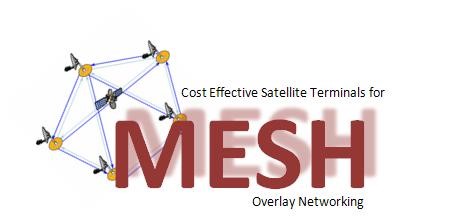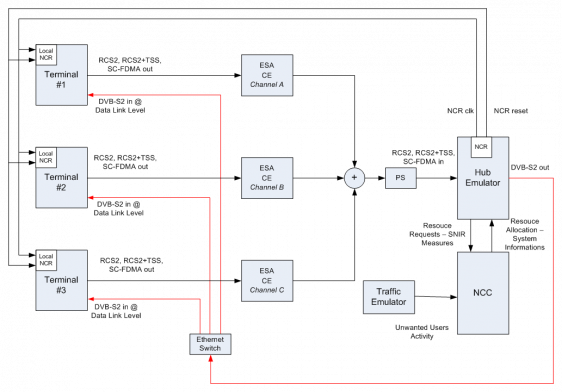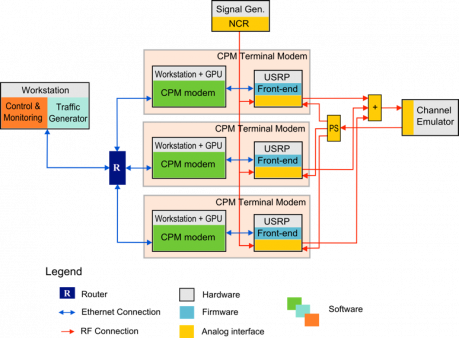
-
StatusCompleted
-
Status date2016-06-27
The MESH Project is a project aimed at implementing two different Test-Beds to fully characterize some new air interfaces and techniques in a MESH Overlay Networking based on DVB-S2/RCS2 specifications in terms of achievable system performance. The first developed Test-Bed is capable of emulating in real time a complete SatCom System implementing the DVB-RCS2 specifications, including Time Slot Sharing (TSS) and Single Carrier Frequency Domain Multiple Access (SC-FDMA), applicable to both LOS and NLOS conditions and both aggregate and not-aggregate types of traffic. The Test-Bed, implemented as SW applications supported by suit HW modules, includes three L-Band terminals supporting several functionalities from physical layer to upper layer, a Hub and the Network Control Centre (NCC). The second Test-Bed is capable of emulating in real time the physical layer of the return link to validate the Continuous Phase Modulation (CPM) using a fully software platform for each of three CPM terminals composed of CPU and GPU. Additionally realistic hardware channel emulators for return links are embedded in the Test-Beds.
The key challenges of the project can be summarized as follows:
- implement air interfaces, some already used in other standards (i.e. LTE), to satellite communications
- implement air interfaces and techniques that permit to save bandwidth and simplify the terminal architecture
- implement the Dynamic Connectivity Protocol (DCP) in order to manage the MESH connectivity
- implement a software terminal to be used as a reference for a future product able to increase the performances in term of data rate
use an already available product (Proteus Modem provided by AIRBUS D&S) in order to reduce the time to market
The implemented solutions provide the following benefits:
- the usage of SC-FDMA permits to identify several advantages: the possibility to increase the waveform efficiency adopting zero roll-off waveforms, the possibility to reduce the Multi-Carrier Demodulators (MCD) complexity (usually at the GW side, also at the satellite side if re-routing on board is available, at the receiver side in MESH applications) and finally the easy equalization capabilities in frequency domain which could allow to estimate, and counteract, channel frequency response.
- Continuous Phase Modulation is a bandwidth and energy efficient non-linear modulation technique with constant envelope which, due to its characteristics, is very suitable in band-limited systems using non-linear amplifiers operating close to the saturation point. In this case, in fact, CPM allows to avoid spectral re-growth from adjacent channels affecting significantly the performance compared to the currently used linear modulation or multi-ring constellations.
The "Time Slot Sharing" technique, in a bi-directional MESH transparent point-to-point connection, allows the simultaneous use of the same return link slot by two user terminals logged in the same beam. This technique allows improving the capacity of a satellite system via better exploitation of the available bandwidth (nominally a 100% increment of the available bandwidth is achievable). The technique can be extended to multi-party conference with 3 or more users, although the gain is reduced as the number of slots required to support a n-party conference is n-1 with a bandwidth improvement of n/(n-1).
This project represents the first step in a roadmap which aims at the development of a MESH communications product to be potentially used both in civil and operational applications. The next step will be to follow a HW implementation for all functions developed in SW in the frame of this project in order to eliminate the data rate limitation imposed by the software implementation.
SYSTEM ARCHITECTURE
The first Test-Bed, implemented by Space Engineering, is summarized in the block diagram of the following figure, it includes three terminals, a Hub emulator, three emulators of satellite links, a Network Control Centre and a Traffic emulator.
This Test-Bed is designed to be able to:
- establish three peer-to-peer connections between 3 different Modem Terminals;
- provide unicast and multicast services;
- support the multicarrier reception
The implementation is based on a real-time fully software emulation platform supported by an appropriate hardware.
An additional unit (not displayed in the block diagram) was included in the Test-Bed to control and monitor all the units. This unit was implemented as a web-based application and permits to define and execute the scenarios used to validate the system with data, video and VoIP flows (both real-time and not real-time video and VoIP flows are supported).

Each MESH terminal is summarized in the block diagram of the following figure. It is implemented as SW application, except for the digital to analogue and analogue to digital conversions, running on commercial PCs.

The second Test-Bed, implemented by Mavigex, is designed to be able to establish three peer-to-peer connections between 3 different CPM Modem Terminals with the aim to emulate MESH connectivity between different nodes. The implementation is based on a real-time fully software emulation platform supported by an appropriate hardware. Each CPM Terminal modem is implemented using a hybrid platform composed of a high performance GPU from NVIDIA able to process CPM algorithms in real-time installed in a Workstation needed to manage also the interfaces between the CPM Modem, the CPM Front-End, and the Traffic generator; a USRP N210 from Ettus Research able to convert data from analog to digital and from digital to analog, able to manage the NCR signal for a synchronous transmission between terminals and able to filter and resample data. Moreover, an additional workstation is dedicated to Traffic Generator and Control & Monitoring functions, and a NCR-like signal generator is used to synchronize the three terminals. The next figure shows the high-level architecture of the CPM Test-Bed where the distinction between hardware, software and firmware elements is highlighted using the colour scheme described in the legend of the Figure.

The CPM Terminal Modem is composed of two main parts: the CPM Modem, which is in charge of the digital transmission and reception of CPM operational modes (Base-Band section), implemented in a PC-like Workstation with a GPU, and the CPM Front-End implemented in an USRP N210 from Ettus which performs both AD and DA conversions, IF to BB and BB to IF conversion and the adaptions required for the multiple access functionality. The implemented CPM scheme is based on a partial response continuous phase modulated signal, serially concatenated with a convolutional code (CC-CPM). The CPM Terminal Modem block scheme is shown in the following figure.
The project was divided in four different phases:
- Phase 1: air interface study and preliminary architecture
- Phase 2: consolidation of the solutions studied in phase 1, terminal and test-bed architecture definition and implementation of the proposed air interfaces
- Phase 3: optimization of Phase 2 implementation, in terms of speed, and terminal preliminary integration.
- Phase 4: terminal and test-bed integration and system performance validation
Project completed




